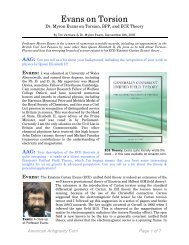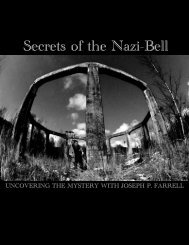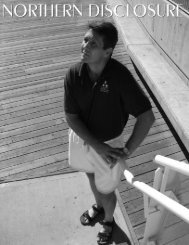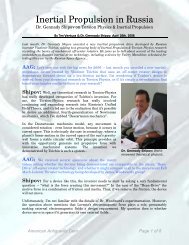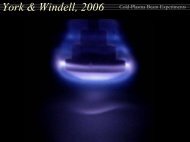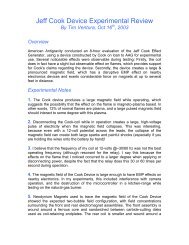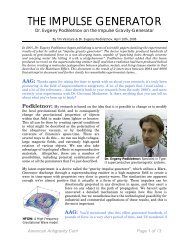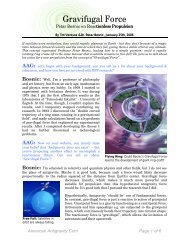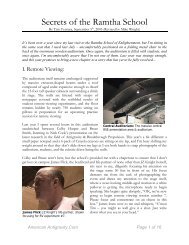Ron-Milione-Philadel.. - American Antigravity
Ron-Milione-Philadel.. - American Antigravity
Ron-Milione-Philadel.. - American Antigravity
Create successful ePaper yourself
Turn your PDF publications into a flip-book with our unique Google optimized e-Paper software.
AAG: So if this experiment works, my understanding is that you're going to see a "dip" in theradar-signature of a scale-model battleship. Do you expect to see any other results, or is thisgoing to be primarily an equipment-based success based on the telemetry alone?<strong>Milione</strong>: Tim, both RF reflections dips as well as “hopefully” transparency of the modelstructure in various portions of the metal.AAG: What are some of the things that could go wrong with this experiment? I'd like toaddress these now, because as you're well aware the critics often use a simple equipment orcalculation error as "proof" that a concept is unworkable. If the experiment doesn't work, anythoughts on how easily most errors might be corrected, and are you planning on bringing anyequipment spares in case something fails at the last minute?<strong>Milione</strong>: That’s a very good question! We certainly hope that the equipment parametersdon’t lead us to inconclusive or negative results, but even Corum’s replication only tested a smallpart of the claims associated with the Hutchison Effect, and let’s face it: in the last 60 years theequipment’s changed a lot. Entire paradigms in electronics have changed, evolved, and beendiscarded in favor or newer technology.The other alternative is simply to locate OEM naval equipment from the 1940’s to try and staytrue to the original <strong>Philadel</strong>phia Experiment technology, but there’s never been a completedescription of they were using ever published. Plus, even if we worked diligently to locategenuine 1940’s-era technology, the parts are still expected to have suffered from old age &neglect. We are planning on doing some dry runs first. I have various metal samples that I’mgoing to ship to John Hutchison within the next two weeks for various types of pre-testingcalibration. The answer to your other question is to have some system backup spares--ABSOLUTELY YES!AAG: All things considered, if this experiment works, I guess that it best demonstrates that1940's-era Electrical Engineers would have at least had the notion that they could make a shipradar invisible using degaussing coils, which is the real basis for William Moore's hypothesis in"The <strong>Philadel</strong>phia Experiment". What kind of credibility will an experimental result bring to theoriginal legend, and do you expect it to touch off a renewed interest in the <strong>Philadel</strong>phiaExperiment as a result?<strong>Milione</strong>: If this experiment works as planned, we’ll have effectively shown that some thatthese early attempts at radar-stealth were based on feasible, scalable ideas that certainly lendsupport to both Corum’s experimental replication and the original <strong>Philadel</strong>phia Experiment.Marshall's "experiments" demonstrated that reflected light from an object could be refracted insuch a way to create a mirage. This mirage would render that object transparent or invisible, afeat based on the statements made by an anonymous scientist who was given the cover name of"Dr. Rinehart," by William Moore. Moore interviewed Rinehart who had met Allende but gavethe eccentric the false name of "Franklin Reno," derived from a road sign describing the distancefrom Franklin and Reno Pennsylvania. Rinehart claimed to have been one of the men whoworked on some of the calculations for the <strong>Philadel</strong>phia Experiment and provided detailedscientific data up to a point. Marshall determined that if this data made no sense, did not 'checkout', then the whole story would lose much credibility. Using the standard scientific method,Marshall carefully read Rinehart's account and researched each scientific detail.<strong>American</strong> <strong>Antigravity</strong>.Com Page 9 of 10



